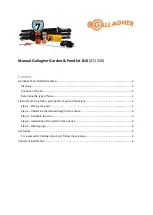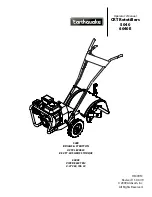
13
OPERATION
Recommended Height Adjustments
Seeding / Multipurpose Height
The seeding/multipurpose blades are used for cutting
grooves for over-seeding and can also be used for
verticutting grasses. To set the height properly place unit
on the lawn surface and adjust the wheel height up (see
Fig. 4 ). Adjusting the wheel height up lowers the blades.
Seeding:
The proper height setting for over-seeding is
approximately 1/4” into the ground. Adjust the wheel
height up approximately one notch. If
set deeper, grass seed being applied may not germinate.
For best results, over-seed in two passes of 1/2
application rate at right angles or in a criss-cross pattern.
Water heavily immediately after seeding then lightly for
10-14 days keeping soil moist.
Slicing
The proper height setting for slicing or aerating is 1/2” to
3/4” into the ground. Adjust the wheel height up one or two
notches.
For crawling grasses such as Zoysia, Bermuda, Bahia, etc.
raise the wheels only one notch. Crawling grasses should
not be sliced too deeply.
For single strand grasses like Bluegrass or Rye, aerate
in perpendicular directions for more even slicing. For
example, slice in a North-South direction on the first pass,
switching to an
East-West direction on the second pass.
As the seeder/multipurpose blades wear they may be
rotated to provide a new cutting edge. The wheels may
be raised to allow the blades to penetrate deeper into the
ground.
Slicing Height
The slicer blade assembly is recommended for slicing,
verticutting or aerating when a thinner blade is preferred.
This is the recommended blade for use on golf course
greens. To set the height properly place unit on the lawn
surface and adjust the wheel height up (see Fig. 4).
Adjusting the wheel height up lowers the blades.
The proper height setting for slicing or aerating is 1/2” to
3/4” into the ground. Adjust the wheel height up one or two
notches.
For crawling grasses such as Zoysia, Bermuda, Bahia, etc.
Raise the wheels only one notch. Crawling grasses should
not be sliced too deeply.
For single strand grasses like Bluegrass or Rye, aerate
in perpendicular directions for more even slicing. For
example, slice in a North-South direction on the first pass,
switching to an
East-West direction on the second pass.
As the slicer blades wear they may be rotated to provide a
new cutting edge. The wheels may be raised to allow the
blades to penetrate deeper into the ground.
Fig. 4








































